Holidays and Celebrations - Aurochs! Imperial Hunting at Byelovvyezh in 1912
Aurochs! Imperial Hunting at Byelovvyezh in 1907
General Alexander Spiridovitch was the Chief of Secret Personal Police in charge of protecting Nicholas II and his immediate family at all times outside of the Imperial Palaces. He served from 1905 until the outbreak of the First World War in late 1914.
His two volume work "Les Dernieres Annees de la Cour de Tzarskoe Selo", (Payot, Paris, 1929) is an invaluable day to day account of the Imperial Family, and important events around them during those years.
Published originally only in Russian and French, it has been a neglected source until recently. The following account of the Hunting Vacation at the Imperial Byelovvyezh preserve is my own translation from the French undertaken in 2004.
Rob Moshein
The Crown forest of Byelovyezhe, Byelovyeskaia Pouschtcha, occupied about an area of 117,000 square dessyatines (=128,000 hectares = 316,000 acres) and was about 200 versts in circumference, and was located in the Grodno government was also the remnant of a virgin forest which was once sacred to the Yatvyags, who have almost been completely forgotten in memory and who fought against Vladimir the Brilliant. (?="Beau Soleil" in french…literally Handsome Sun).

Above: Imperial Byelovvyezh Hunting Lodge, By courtesy of the Beineke Rare Book and Manuscript Library, Yale University
Oaks, pines and fir trees formed a nearly virgin forest which was impenetrable in places. A multitude of horned and unhorned beasts inhabited the forest for centuries, including the king of the forest - the Zoubr, the Auroch. Much earlier there were bears and other ferocious beasts as well, but little by little they disappeared.
The princes of old Russia loved to hunt in the forest. It was the same with the Kings of Poland when they held the land; on its return to Russian possession, our Emperors took up the ancient tradition. By an ukaze of 1803, Alexander I had prohibited the carrying of a hatchet in the forest. Alexander II hunted bears there, and in 1860 had a small wooden hunting palace built there.
Under Alexander III, they gave the hunts in the Byelovyezhe forest a regular organization and had a stone palace built. The former ordnance officer to Grand Duke Nicholas Nicholaiovitch, Andreyevski, was the first Estate Manager of the reorganized Byelovyezhe, named to that post in 1889, he did much to organize the hunts. He was the first one to organize a regular hunt for beasts of prey, and he brought in, to restock the game, Siberian stags, deer from Bohemia, and he even tried to transplant reindeer from our northern regions into the forest.
Under Nicholas II, the Byelovyezhe forest was a model of cultivation, organized for hunting and overseen by an administration of forestry and hunting headed by a manager. In the center of the forest was a large open area with four villages, one of which was called Byelovyezhe. In the middle of the open area was a stone palace, of two stories, the old palace, the suite's building, and the commons; behind the village of Byelovyezhe were the administrative services. The palace was surrounded by a park, studded with ponds; next to the palace was a little church.
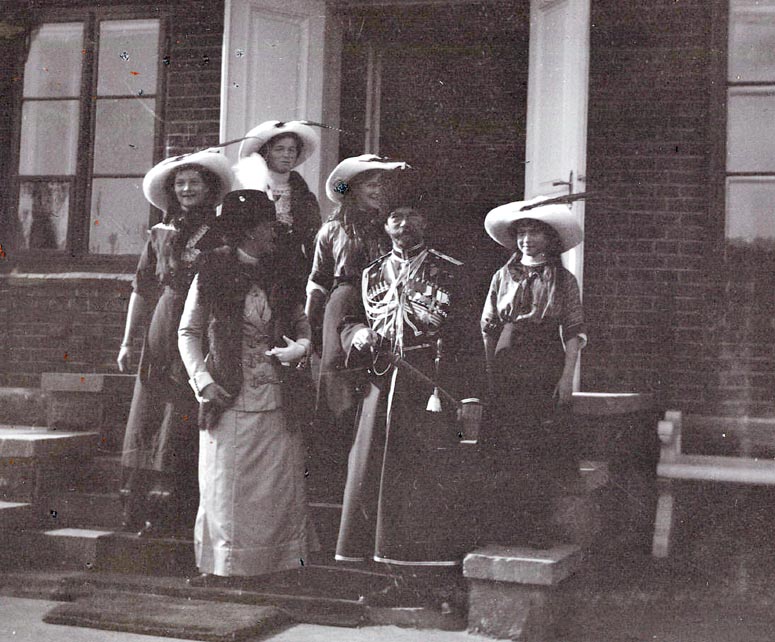 Above: The Russian Imperial family at the Imperial Byelovvyezh Hunting Lodge in 1912, By courtesy of the Beineke Rare Book and Manuscript Library, Yale University
Above: The Russian Imperial family at the Imperial Byelovvyezh Hunting Lodge in 1912, By courtesy of the Beineke Rare Book and Manuscript Library, Yale University
Twenty five thousand stags, eighteen thousand wild boar, not to mention the numerous wild goats, deer, furred animals and 770 aurochs who were the pride of the forest; this was the population of quadrapeds, duly counted and noted. The widely held general opinion, and having even been found in guidebooks, was that the aurochs were on the verge of extinction, was not true. To the contrary, the number of aurochs was growing little by little and they had even succeeded in transplanting some of them into the forests in Gatchina and the Caucasus.
On the other hand, the elk, who can not stand the smell of the stags, had almost disappeared from the forest from the increased population of stags. There were only about sixty head of elk left relegated to a forgotten swampy and inaccessible corner of the forest.
The forest was divided into five estates. It was crossed by roads, both large and small. The forest guards, armed with revolvers and knives, watched over the estates. On their part, the hunt guards, armed with rifles, fought off poachers, watched over the animals, and drove off the beasts of prey.
It often happened that the hunt guards had to take down a rogue auroch. They said they had to do this, because the old aurochs who had become separated from their herd would, because of their isolation, become wild again, and would attack both man and beast.
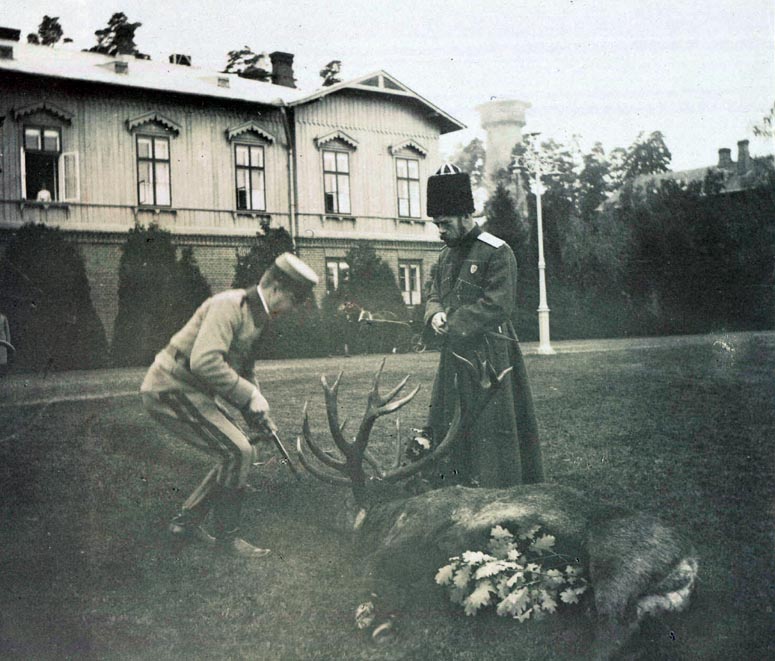 Above: Nicholas II, Tsar of Russia with a stag at the Imperial Hunting Lodge in Poland, By courtesy of the Beineke Rare Book and Manuscript Library, Yale University
Above: Nicholas II, Tsar of Russia with a stag at the Imperial Hunting Lodge in Poland, By courtesy of the Beineke Rare Book and Manuscript Library, Yale University
These rogue aurochs would charge the young females in heat. Whenever they would try to mount one of the young females, they would invariably break their back because of their immense weight (25-40 puds= 410kg, 910lbs. - 655kg, 1440lbs.). While the young aurochs are black, with a slightly grey tone, the rogue aurochs are brown.
You see a rogue auroch who has wandered to the side of the road. He heard the noise of a peasant's cart and immediately became still, only his tail stirs. The peasant knows that if he tries to pass he will be killed. There is nothing for him to do except turn around and go back the same way, or better yet, light a fire up wind. The auroch, who avoids smoke, would immediately leave.
During the summer, the beasts would eat on their own. But during the winter, it was necessary to provide them with food. Four hundred solid sheds were built out of oak trunks and distributed throughout the forest, serving as stores for the food. Racks were hung on the side of the sheds. Twice a week they would fill the racks with clover hay, potatoes, salt, beets. The animals would wander around the racks always seeming to know what day they should wait for the game warden to come, generally around noon. Once the game warden had refilled the racks and left, the animals would come from all over and one could see a stag placidly eating off of the same rack as an impressive auroch.
Eight hundred dessyatines (= 875 ha=1260 acres), surrounding an enclosure, formed a kind of game preserve in which they had gathered examples of all of the flora and fauna of the forest. This park was called the "menagerie". Many tourists came to visit the forest and the "menagerie".
An interesting incident happened one day there. A small auroch had died, and a veterinarian was called in to establish the cause of its death. This needed to be done with a some caution, as they were afraid of an infectious disease. However, the aurochs in the menagerie surrounded the dead body and would not let anyone in. They had to resort to a ruse: they attracted the aurochs away to another area by luring them with their favorite foods so they could go in and get the body. The next morning they saw that the aurochs had destroyed the enclosure and had disappeared into the forest. No one had ever seen behavior like this before. Those persons familiar with auroch behavior saw it as an act of revenge for the removal of one of their young, even a dead one.
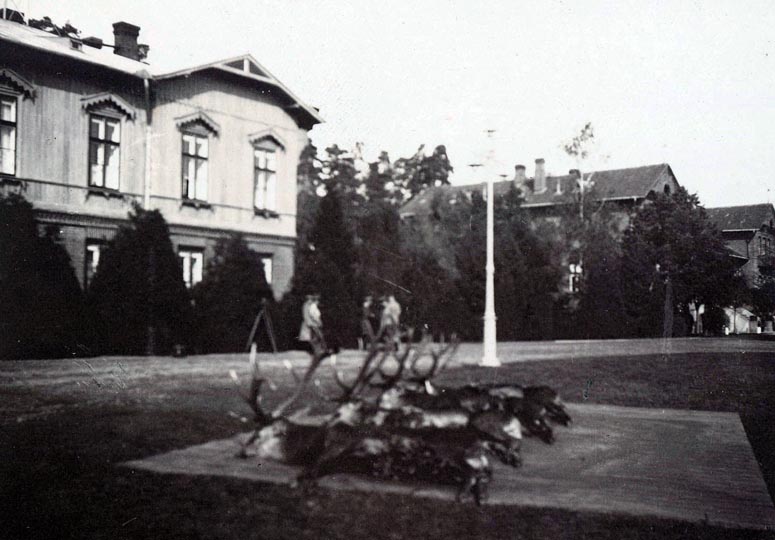 Above: Imperial Byelovvyezh Hunting Lodge - stags, By courtesy of the Beineke Rare Book and Manuscript Library, Yale University
Above: Imperial Byelovvyezh Hunting Lodge - stags, By courtesy of the Beineke Rare Book and Manuscript Library, Yale University
At the time of which I am speaking, the Byelovyezhe forest was managed by Mitrophane Stepanovitch Golenko, and excellent man, honest, hard working and who loved his job. He brought order to the organization of the estate and most notably created a remarkable scientific museum there.
I made his acquaintance immediately upon my arrival at Byelovyezhe. He told me everything I wanted to know about the forest and showed me the palace.
The new hunting palace, of stone and two stories, was built by the order of Emperor Alexander III in the anglo-saxon style by Count Nicholas Ivanovitch Rochefort, who had been instructed to have it built in Russia and using Russian materials for anything at all he needed to build the palace.
The Emperor and his family had gone there for the first time on August 15, 1894. The work had just barely been finished in time. The architect's daughter told me that during the first dinner there for the Emperor and his family, who had also invited her father, the electricity failed. Everyone was silent. Several anguished moments passed, which seemed like an eternity.
Finally the lights came back on. The Count, who had not yet regained control of his emotions, looked nervously at the Emperor.
Alexander III, who understood and surprised his look, said to the Count with a huge smile and emphasis on his words: "You know, the same thing happened to me when I got to Gatchina."
That was the first and last trip the Tsar Peacemaker made to Byelovyezhe.
All of the Palace was simple, proper and comfortable.
In the entry hall, one could see enormous stuffed aurochs killed by the Emperors. Auroch heads were mounted on the wall along the stairway leading to the second floor.
On the ground floor there was a dining room, huge and bright, which could seat 150 people. Its walls were hung with the most interesting examples of animal's horns killed in the hunts and magnificent watercolors. Among the trophies, they had a set of stag antlers with 28 branches. That animal had been killed in 1903 by Prince V.S. Kotchubey who was considered among the best of shots.
On the second floor was the Emperor's study, which was a most interesting room. It held a polished oak table 44 verchoks in diameter (=1.96m = 6.5ft). Around the room were a succession of couches made from oak from trees more than a thousand years old. The area of the forest no. 108 still held many other oaks over a thousand years old. One of them was over 1200 years old. That veteran, a living witness to the founding of Russia itself, was surrounded by solid supports. The Germans themselves, who had pillaged the forest during the war, had spared that oak, and had even done everything possible to protect it.
In that same study they also kept the plates on which they offered Their Majesties bread and salt each time they arrived at Byelovyezhe. The Empress had the habit of using a diamond to engrave on a balcony window each date of the arrival of the Imperial Family. The last date engraved there was 1903. Their Majesties had not returned for 9 years.
Near to the new Palace, next to a pond, was the old palace; small low, only one floor, somber, and of only five rooms. It was very damp. Very close by they preserved a stone obelisk from the time of Stefan Batori. Another similar obelisk was in the forest.
A short distance away was the house designated for the suite: it was of two floors and of 40 rooms and had electricity.
Around the palace a park had been planted which occupied an area of around five dessiatines (5.4ha = 13.5 acres). Royal pheasants, with long magnificent tails, speckled with black, yellow and white, some black and white, most silver, animated the countryside.
A deliciously calm and tranquil atmosphere held sway in the forest in the summer, above all at nightfall, when the silent dusk was not disturbed by the sound of church bells from the nearby village. One wished it would go on forever.
But on the other hand, during October and November, somber, sad and rainy, when the wind blew hard in the forest and engulfed it with noise between the trees and bending their centuries old tops, and one heard all around the bellows of the stags, from tens of thousands of animals, it seemed as if all of the elements had been unleashed against man and anyone who was not accustomed to life in the forest would feel anguish and terror and would want to flee away, as far away as possible.
The Emperor and his family, as well as Grand Duke Dmitri Pavlovitch, arrived at Byelovyezhe on September 1st. They were received by the entire administration, Governor Borzenko, Prince Kotchubey who had arrived earlier, and by Count Velpolski who had come from Spala. As well as those people who always accompanied the Emperor, the manager of Imperial Hunts, General aide de camp, His Serene Highness Prince Galitizin, and His Majesty's First Huntsman, Dietz.
They went to the Palace in magnificent carriages drawn by two horses. The Emperor left the next morning for maneuvers at Byelostock, and the hunt commenced on his return.
At eight in the morning they went by automobiles to the entrance to the hunting area; they then got into brakes and followed along a forest road until the firing line where the hunters separated, each going to a place corresponding to his "number", that is to say his stand, completely hidden with branches and greenery and behind which he could hide chest high.
The Emperor generally took the center stand; to the right and left from him were the "numbers" of Galitzine and Dietz, as they were the best shots. This time, it was Grand Duke Dmitri Pavlovitch who was placed to the Emperor's left. The other hunters occupied the "numbers" they had been given in advance. Behind each shooter was a servant with the rifles. The servant also had a long spear in a sheath. My boss Dyedyuline was not a hunter; so we placed ourselves, he and I, on one side of the firing line. He always had his cane in his hand, while I was armed.
When the hunters arrived, one section of the forest, about one verst and a half (1.6 km and 1 mi.) in length and one verst (1 km and .66 mi.) wide, had already been surrounded from behind by the soldier beaters. They carried red clothes, to upset the animals and were usually armed with bats.
Along the sides, that section had been roped off with little flags tied close together on it which would disturb the animals and prevent them from escaping out. The hunters took their places. Everything was ready. The commander of the hunt, a brave old Czech named Neverli, shouted the order. The shrill sound of trumpet cut the air and echoed across the forest.
"BEEEE-GINNN! BEEEE-GINNN! BEEEE-GINNN!"
In response to the signal, the forest began to ring with shouts and all sorts of noises, and cracks which formed a distant echo. It was the chain of beaters beginning to move. The huntsmen on horseback would keep order. The game wardens were placed near the ropes with the flags and shook the ropes. The multicolored scraps of cloth hurt the eyes. Soon the noise of the beaters got nearer and nearer bit by bit, always equal and uniformly, always keeping a very high pitch to see an animal and boucing from one side to another in their pursuit. Complete silence in the stands. The hunters are on their guards. The animal, tracked by the beaters instictively knows that danger menaces from ahead and then runs back toward the center of the section. However they are immediately frightened and begin to toss from side to side, leaping over obstacles, and finally head in the only free direction, which is of course toward the hidden hunters behind the branches and greenery. Immediately a gun shot rings out, then another and another at closer and closer intervals.
Having lost many males, a herd of stags crosses the section at an insane speed, jumping along their way through tree branches which flutter loudly. A herd of wild boar in a straight line run while loudly snorting. And then a fox manages to cross the firing line safely, he stops fixed under the rope with flags, as if hypnotized by the red color.
From time to time one could see hares appear.
Then we could hear an extraordinary noise. Far off at first, it came closer and closer. The ground shook. It was aurochs. We then saw one single auroch who clearly crossed the section, head lowered and tail raised.
The beast was furious and genuinely frightening to see. It was followed by another auroch, a third, and then more.
They ran along their path spreading destruction and the formidable noise which they made echoed across the forest and followed them along their retreat…But they did not fire on them, because an epidemic had recently struck the herd, and the order had been given not to shoot them.
Then the clarion sounded retreat, and the beaters stopped thirty paces from the firing line.
The hunters were over excited. The huntsmen went back into the forest looking for the killed animals. Many of them had only been wounded and they might run off. The huntsmen ended by retrieving them and by finishing them off.
After four hunts, they went to lunch. By tradition, lunch was served on gold and silver plates. For wine, they served a madeira which was made locally on the estate. They also took a little vodka.
The Emperor shot well. In Byelovyezhe he used an ordinary military rifle, which was slightly modified and shortened a little bit.
During one hunt that year, right in front of Grand Duke Dmitri Pavlovitch, the Emperor brought down five stags at the same time with just five consecutive shots from his stand.
During another of the hunts the following happened. A herd of aurochs ran very furiously between the Emperor's stand and the Grand Duke's stand. There was not a second to lose. They each had to leap out of their stands to escape being trampled. The Emperor jumped to the left and the Grand Duke to the right. The herd noisily ran straight through the firing line and into the forest, having trampled and destroyed everything n their path, including both stands.
During that same season, Grand Duke Dmitri Pavlovitch had only one occasion to kill an auroch. Here is how it happened.
A rogue auroch had been brought into the menagerie, and it unquestionably had to be killed. The Emperor asked the Grand Duke to be in charge of it.
The Grand Duke went to the menagerie accompanied by a hunstman.
He saw off in the distance a herd of aurochs, with the rogue male in the middle.
When the hunters got to about five hundred paces from the herd, the herd quietly trotted off; except the rogue male, who turned directly toward the hunters, fixed in place.
After just a few moments, the terrible beast stirred and went toward the hunters, his head lowered. The Grand Duke stopped. He let the animal approach to about fifty paces, then shot. The auroch fell like a stone and toppled the tree he was next to when he fell…the bullet had gone straight through his skull.
The Grand Duke took a piece of the fallen tree trunk as a souvenir. The following year the administration of the hunts delivered to him the stuffed auroch he had killed.
The Emperor was too kind, too sweet and loved all forms of life too much to be a cold and cruel hunter. He once let a herd of stag pass without firing a single shot. When he was asked why he had refrained from shooting them, he said that he found it too cruel to just shoot into the herd at random and wound many of the animals by mistake.
He also would spare hares, out of simple pity for those frightened little creatures, running blindly ahead, and, for lack of better terms, offering themselves up to be shot.
The Emperor liked hunting, but only as a simple distraction, a rest, as a chance to enjoy the outdoors. He did not, however, love hunting for its own sake.
The scenery offered by the hunts at Byelovyezhe was sometimes so striking that even simple men could not resist its charms. One day, after the hunt was finished, the Emperor was chatting with the beaters, when one of them, a soldier, left ranks and took several steps in the Emperor's direction.
His hand at the visor of his cap, he began by extolling the beauty of the forest. He said that the weather that day was magnificent and the forest was truly delightful. He declared then that he wanted to stay there always, to enjoy its calm and tranquility, and he asked the Emperor to grant him a favor and to find him a job there in the forest.
The Emperor understood what had happened in the soul of that little soldier, and was touched by the charm of his nature. He said a few kind words to him and promised that he would "intervene" on his behalf.
Just moments later, the Emperor went up to Golenko and said that he had a favor to ask of him. Golenko became troubled. The Emperor then asked him to use his patronage to find a job for the soldier/beater who had come to show his love of the charms of nature.
The soldier was transferred to the forestry guard. However, when autumn came with its rains, and the forest began to echo from morning and evening with the bellows of the stags, and when winter spread its white death shroud over the entire forest and deathly silence held sway everywhere, our little poet became stricken with a terrible anguish and an indescribable despair. He began to beg that they let him leave. It goes without saying that they did nothing to try to keep him there.
In the evenings, all the animals killed during the hunt that day were brought onto the field near the Palace, and laid out in rows according to their kind. Their horns were wrapped in greenery. After the Emperor's dinner, they would light resin on fire in two large urns placed on each side of the field. Nyeverlye, moved, walked in review past the last row of the trophies.
The Emperor would appear on the front steps of the Palace. He wore a "Tcherkesska" and was surrounded by his children, some members of the suite and everyone who had participated in the day's hunts.
Nyeverlye would approach His Majesty and would show him using his hunting knife, flamboyantly drawn out of its sheath, the largest of the animals killed, there, at the end of row, he made a show of saluting him. The brass band, hidden in the bushes, played a piece of music in honor of that animal. They had a piece of music for each beast. One felt something as powerful, and heavy as the animal itself in the dedication piece of music for the auroch. That played for the stag seemed lighter, graceful; happy and bouncy notes were what they played in honor of the hares.
It often happened that the hunters did not know exactly who had killed which specific animal. And so, this happened one day, there was quite a discussion between two of the hunters about a stag. Each firmly believed that he had killed the animal. They each put forward their own assertions, and all of that day's hunters were listening to the discussion, even the Emperor. And just then, out of a group of the huntsmen, a brave peasant, with head bared, came up to the Emperor, and told him: "No, no, Your Majesty, no one killed that animal. He killed himself ran right up into a tree, I saw it myself. He just fell like that, stone dead."
After examining the creature, there was a discussion among the hunters who then told Golenko how the different pieces of the animal should be given to which person. The Emperor thanked Nyeverlye and the huntsmen and then went back inside the Palace. The hornsman of the hunt played a march.
On those days when they did not hunt, the Emperor would happily go for walks on foot. A few days after he arrived, he left the Palace alone, and went rather far and found himself in front of a small distillery where the farmer, a Jew, made turpentine. Having greeted the farmer, the Emperor asked him for a bottle of turpentine.
"Impossible" the Jew said, "we do not sell retail." The Emperor smiled, said goodbye to the farmer and went along his way.
"What did the Emperor ask you?" the security agent following the Emperor from a distance asked when he came up to the Jew.
"What Emperor? Where?? The Emperor??" the Jew asked, and he suddenly understood what the agent meant, and he fell to the agent's feet.
He was scared to death, when he realized the mistake that he had made, and he expected the most terrible consequences as a result of it.
When the Emperor was told about the state of anxiety the poor Jew was in, the Emperor was amused, and had him sent 25 rubles along with another request for a bottle of his turpentine.
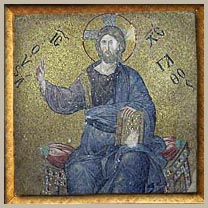




 Imperial Bedroom
Imperial Bedroom Portrait Hall
Portrait Hall Mauve Room
Mauve Room Maple Room
Maple Room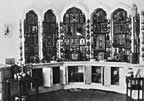 Aleksey's Bedroom
Aleksey's Bedroom Nicholas's Study
Nicholas's Study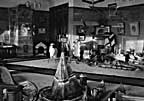 Aleksey's Playroom
Aleksey's Playroom Formal Reception
Formal Reception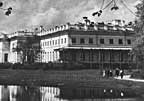 Balcony View
Balcony View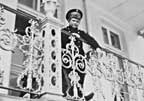 Aleksey- Balcony
Aleksey- Balcony Children-Mauve
Children-Mauve Nicholas's Bathroom
Nicholas's Bathroom Alexandra- Mauve
Alexandra- Mauve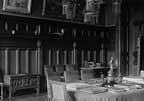 Nicholas's Reception
Nicholas's Reception Tsarskoe Selo Map
Tsarskoe Selo Map